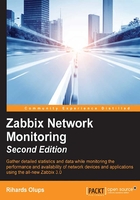
Chapter 1. Getting Started with Zabbix
It's Friday night, and you are at a party outside the city with old friends. After a few beers, it looks as if this is going to be a great party, when suddenly your phone rings. A customer can't access some critical server that absolutely has to be available as soon as possible. You try to connect to the server using SSH, only to discover that the customer is right—it can't be accessed.
As driving after those few beers would quite likely lead to an inoperable server for quite some time, you get a taxi—expensive because of the distance (while many modern systems have out-of-band management cards installed that might have helped a bit in such a situation, our hypothetical administrator does not have one available). After arriving at the server room, you find out that some log files have been growing more than usual over the past few weeks and have filled up the hard drive.
While the preceding scenario is very simplistic, something similar has probably happened to most IT workers at one or another point in their careers. Most will have implemented a simple system monitoring and reporting solution soon after that.
We will learn how to set up and configure one such monitoring system—Zabbix. In this very first chapter, we will:
- Decide which Zabbix version to use
- Set up Zabbix either from packages or from the source
- Configure the Zabbix frontend